If you are into visual novels at all, you’ve probably already played Steins;Gate (and if you haven’t, you should). But Steins;Gate is only one in a series of games tied together by their excellent sci-fi tales – and improper semicolon use.
But if I’m going to try to explain the Science Adventure series, I’m going to need someone to ask all the stupid questions and make me seem even more intelligent and knowledgeable than I already am.
This story originally appeared in January 2016, and has been reposted to coincide with Steins;Gate 0’s PC release this week.
…Hey! Disembodied voice that haunts me (and occasionally Fahey), that was your cue!
::Sighs:: Not even trying to be civil anymore, are we?
Oh, come on. We may have come to loathe each other over the course of these explainers, but it’s fun to learn new things. Besides, it’s not like you have a choice.
…Fine. Let’s get on with it.
That’s the spirit.
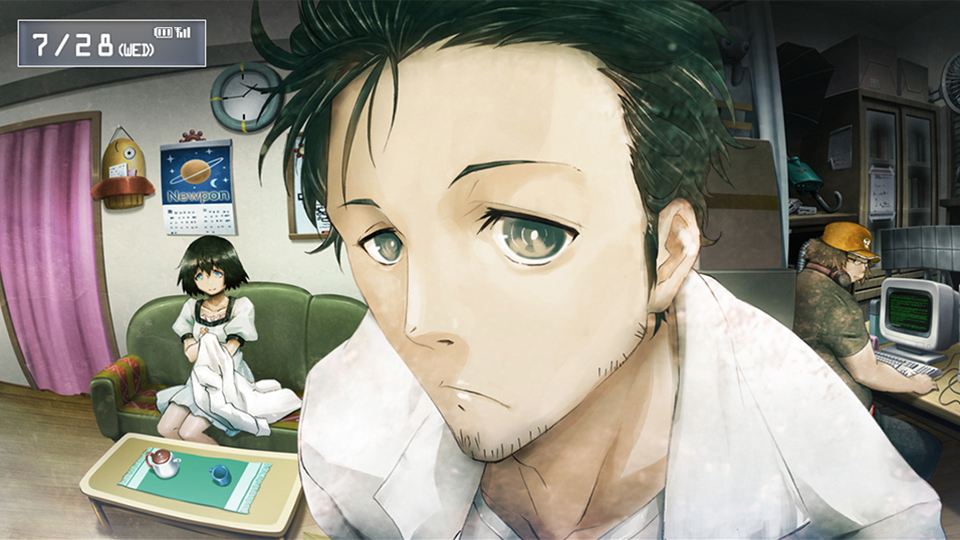
Alright, so what is the Science Adventure Series?
Made by 5pb Games and Nitroplus, Science Adventure is a series of five core games: Chaos;Head, Steins;Gate, Steins;Gate 0, Chaos;Child and Robotics;Notes.
I see what you mean about the improper use of semicolons.
It’s pretty much the series’ trademark. Anyway, there are also several side stories, non-canon spin-offs – and several special editions of the core games with additional content.
So what‘s the pitch? What‘s it about?
That’s a complicated question. Simply put, all five main games take place in the same world and are each centered around a core sci-fi concept. The two Chaos games focus on people with reality-altering powers. The two Steins;Gate titles are about time travel.
And Robotics;Notes?
It’s about a group of kids building a realistic Gundam.
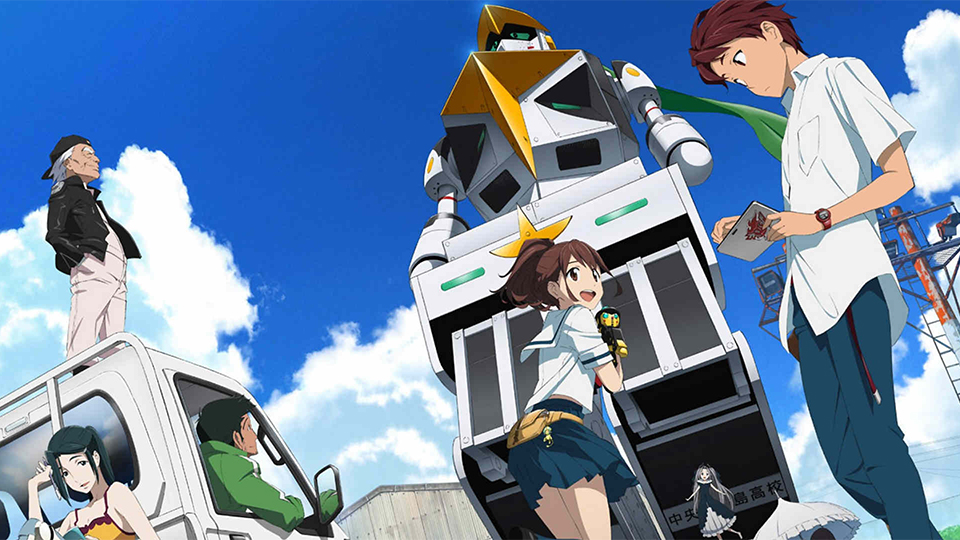
I‘m not sure whether I am more excited or incredulous about the idea. And what do you mean by “realistic“?
Well that’s one of the best parts about the series as a whole: There’s actual science in it. In the case of Robotics;Notes, it talks a lot about how the giant robots would be too top heavy for their legs to even support the weight, much less move – stuff like that. Steins;Gate goes fairly in depth into the main theories of building a real-world time machine (and why each wouldn’t work) while the Chaos games deal with the nature of perception, reality and antimatter.
So it‘s scientifically accurate?
Oh Christ no! But like the best science fiction, it at least starts in real science before it throws itself headlong into the fiction.
Alright, so far so good. You‘ve got my attention. Now what?
Well, let’s break down the series game by game and talk a bit about each. Let’s do them in the series’ fictional chronological order and start with Chaos;Head.
Alright, if you were going to pitch Chaos;Head to me, how would you describe it?
Persona 4 meets Se7en – only way more messed up.
Jesus.
Yeah. Well, anyway, Chaos;Head begins in 2009 and follows a hardcore anime otaku (and borderline shut-in) named Takumi who lives in a cargo crate on the top of an apartment building in Tokyo’s Shibuya District (the same area as in The World Ends With You). One day while feeding his off-brand EverQuest addiction, he is sent pictures of a horrific murder – a man impaled to a wall by hundreds of stakes. He ignores it as a prank; but while walking home the next day, he comes across that exact scene – with the addition of a pink-haired girl, stakes in hand.
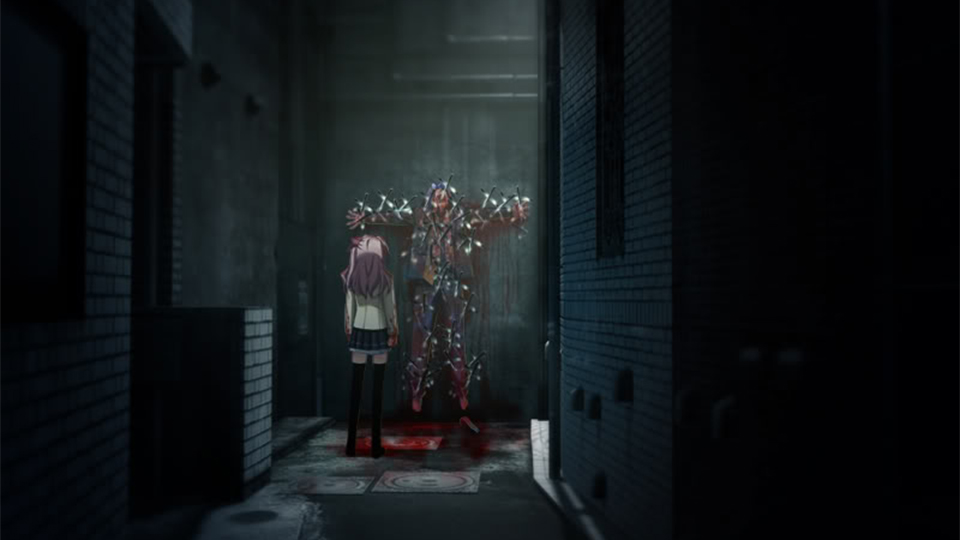
Eep!
Soon, Takumi finds himself at the center of a series of bizarre serial killings. Suspected by the police while, at the same time, sure that he is the next target, Takumi begins to be overcome by delusions that run the gamut from horrifying to erotic. He tries not to solve the mystery, but rather to escape it.
I assume he does a piss poor job of that.
You could say that. Especially as a stream of strange girls begin entering into his life – changing the very nature of his “2D-only” reality. Soon, he’s not even sure where the delusions end and reality begins.
So, this is a visual novel, right? Is there any gameplay?
Sure. Basically, you are in control of Takumi’s delusions. You choose whether he sees a positive one (comical and/or erotic), is shocked by a negative one (gory or otherwise terrifying), or manages to stay grounded in reality.
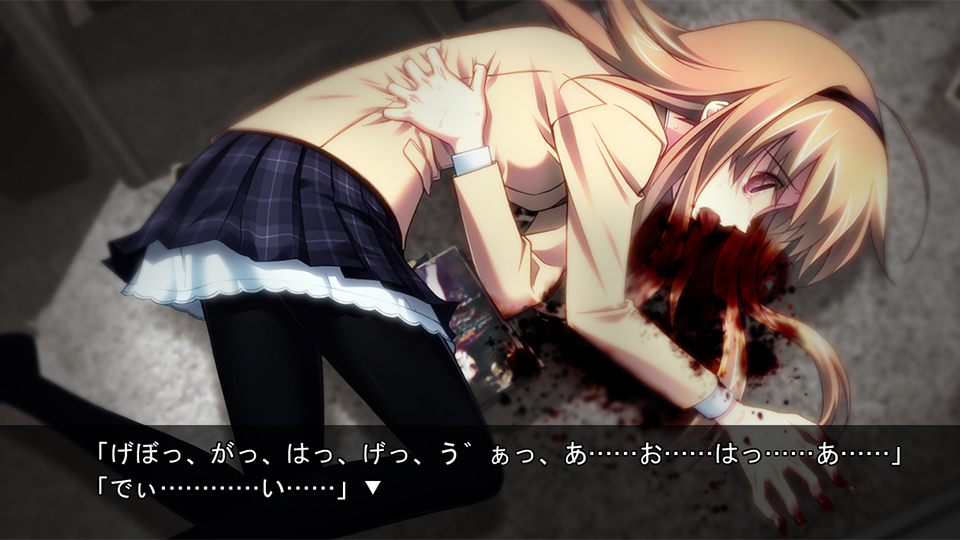
Does this affect the final outcome of the story or anything?
In the new game plus version of the original game it does – though the game only has three endings. In the remastered version, Chaos;Head Noah, his delusions affect a lot more as there are a ton of new routes through the story.
So how is Chaos;Head overall?
Well, it’s relatively short compared to the rest of the series and has a staggeringly unlikable main character. I’m not sure whether you are supposed to sympathise with him or enjoy torturing him. Moreover, the game’s main cast never really comes together as a group – it’s more like Takumi is wandering in and out of their stories than they are a vital part of his. It’s not a bad game by any means – as both the world and plot are gripping – but compared to what comes next, it might as well be nothing.
…Here it comes.
Steins;Gate is simply one of the best visual novels – if not the best – ever made: amazing plot, great characters and emotional moments. It’s a masterpiece of narrative storytelling. I still feel its anime adaptation is the best anime I have ever seen.
Jesus, you‘re such a fanboy!
That’s a funny way of spelling “level-headed and objective”.
::Sighs:: Whatever… Let‘s get this over with. Tell me about Steins;Gate.
Steins;Gate takes place in 2010 and is the story of Okabe, a university student (read: self-styled mad scientist) living in otaku mecca Akihabara, who accidentally invents time travel.
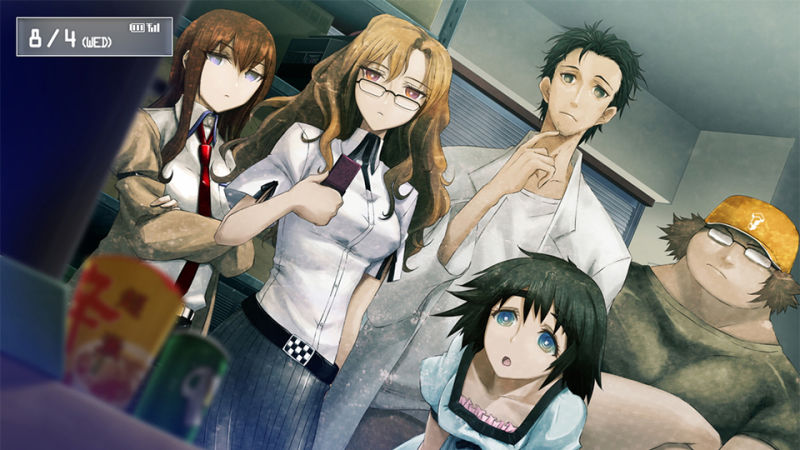
…Well, that was surprisingly succinct.
Oh we are far from done. One day, after a seminar on the subject of time travel, Okabe comes across the recently murdered body of Kurisu – an 18-year-old genius neuroscientist. But when he sends his friend a text about it, the world changes into one where Kurisu is very much alive – not to mention intrigued despite herself by this crazy guy who insists he saw her dead.
Am I sensing a pattern here of these games starting with horrible murders?
Yes. And quiet, you. Anyway, much of the first half of the game deals with Kurisu, Okabe and his friends as they figure out how and what he’s done – that is, sent an email into the past – and how to repeat it. And then there are the various mails they send to improve their lives.
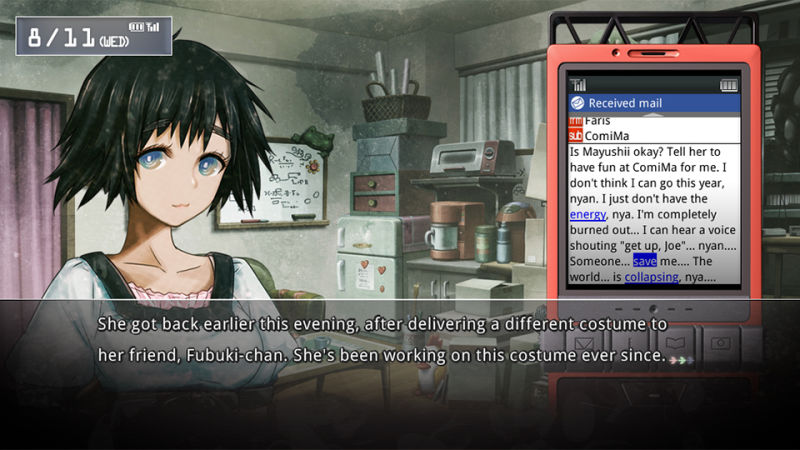
And the second half?
Dealing with the consequences of their actions – and trying to overcome the almost hateful way the multiverse is structured. When it comes down to it, it’s the story of a normal man in a no-holds-barred, knock-down, drag-out battle against fate itself.
So what‘s the gameplay like in this one then?
Player interactivity in Steins;Gate is done through Okabe’s cell phone. Responding to messages, making calls and even taking out your phone at certain times can drastically affect how the plot unfolds. In other words, the game changes based on how Okabe interacts with the others and what information he gets at what time.
Huh. So wait, back to the plot for a second. It sounds like Steins;Gate is the beginning of the story. So what is Steins;Gate 0, then? A prequel?
I can see how the title would lead you to think that, but no. Steins;Gate 0 is actually a midquel – it takes place in the middle of the original’s “true ending”.
Any way to talk about Steins;Gate 0 without spoiling the entire first game?
Sure. Basically, Steins;Gate 0 is the story of Okabe as a broken man. While having achieved his original goal, the price is so high that he is a shell of his former self. Instead of continuing on and fighting for a happy ending, he destroys the time machine and tries to move on with his life.
Haunted by his memories and suffering from severe PTSD, he connects with the colleagues of a dead friend. This in turn leads to a new adventure where Okabe learns that even in a world without time machines, the knowledge that one can be created can be enough to destroy the world.
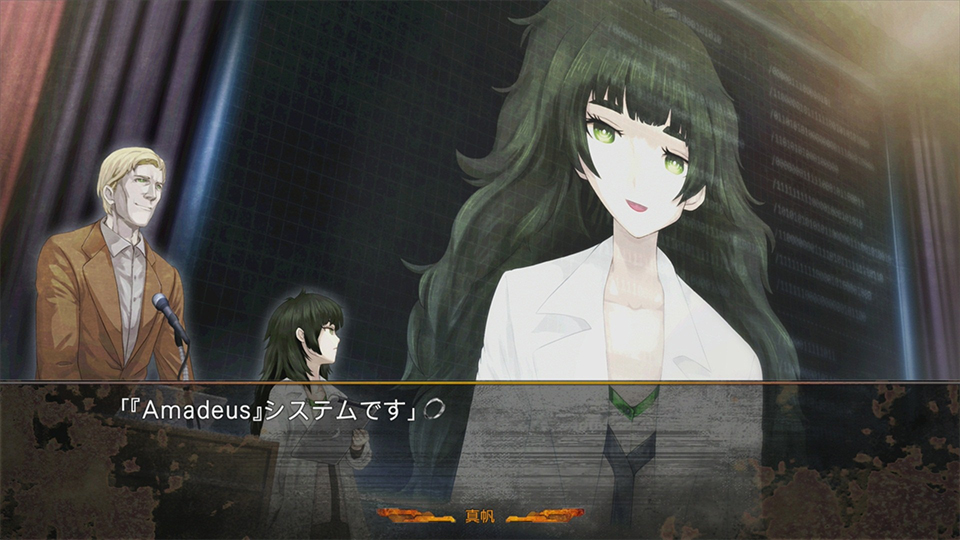
So… what you‘re saying is it’s dark.
That’s putting it mildly. However, at its core, it really is a story of redemption – of a man going back to the proverbial battlefield one last time even as the world collapses around him and finding the strength to go on. It’s the missing story showing all that it took to get the original’s “true ending” – which in turn gives the first game’s ending even more emotional power.
Is the gameplay the same as in Steins;Gate?
Sort of. Both games are controlled by the cell phone. However, what affects this game are key moments where you have the choice to answer the phone or not. What’s interesting is that, despite no time machine existing, both choosing to answer the phone and choosing not to answer the phone causes the timeline to shift in dramatically different ways. There’s no way to stay on the initial timeline. Why exactly this happens is one of the core mysteries of the game.
Yeah, that sounds like a good mystery. So what‘s next? Chaos;Child? Is that a direct sequel to Chaos;Head?
More of a thematic sequel, if anything – with all the murders, delusions and reality-altering powers. While the entire cast of Steins;Gate returns for Steins;Gate 0, only a single supporting character from Chaos;Head physically shows up in Chaos;Child – we focus on a whole new cast instead.
In fact, the characters of Steins;Gate have far more interaction with the story than the Chaos;Head characters when it comes down to it.
I feel like we‘re getting way ahead of ourselves here. Back up a bit and pitch me Chaos;Child.
X-Men meets Persona 4 meets Se7en – only way more messed up.
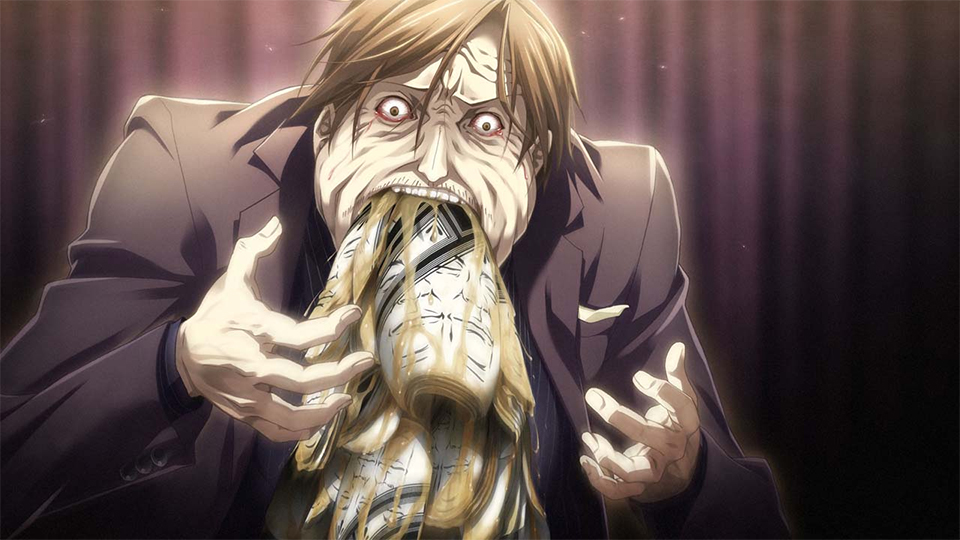
…Alright, this time that description needs explaining, I think.
OK, backing up to Chaos;Head a bit, it both begins and ends with a massive earthquake levelling Shibuya. Chaos;Child picks up in 2015 and follows a group of teenagers who survived the quake as children – though most of their friends and family did not.
The main character this time around is Takuru. While a bit awkward when it comes to the opposite sex – other than his best friend and his sister, anyway – he is far from a shut-in and is the president of his high school’s newspaper club.
Still waiting for the X-Men meets Persona 4 meets Se7en connection.
Basically, he is the first to notice that two recent, gruesome murders happened on the same dates as the serial killings in Chaos;Head. Soon he figures out the pattern behind the victims and discovers that he and many of his friends are possible targets. With this, it becomes a cat and mouse game. Can he catch the killer and save his friends before the next murder date comes to pass?
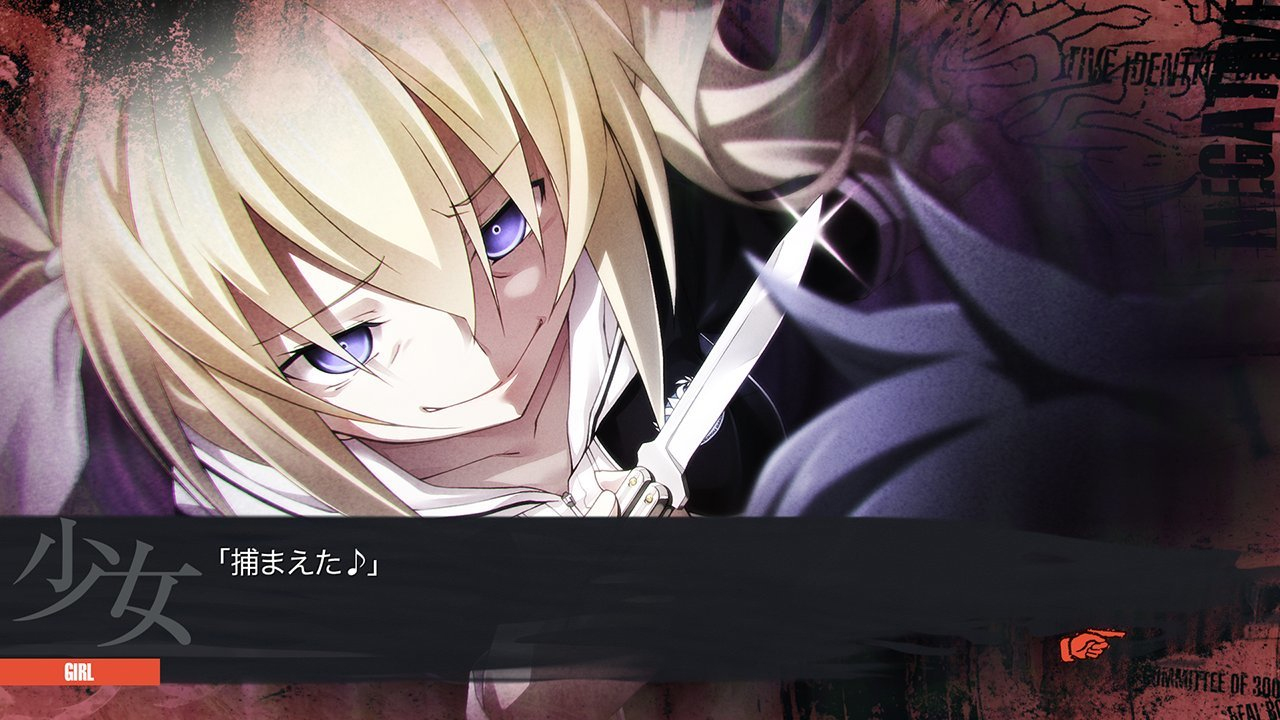
And the X-Men thing?
Unlike in Chaos;Head where several characters have massive, reality-altering powers, the characters of Chaos;Child have a lesser form of the power. For one character it manifests as the ability to detect with 100 per cent certainty when someone is lying. For another, it’s full-blown pyrokinesis.
Superpowered teens solving a murder mystery. Got it. How‘s it play?
Identically to Chaos;Head for the most part, with you choosing which delusions Takuru sees or if he stays in reality. There’s also a bulletin board with a map of the area which you return to time and again. You use it to sort out all the evidence you’ve gathered and pick the correct conclusions to continue the story.
There are also several different routes to the story that change based on the delusions you see – though this only happens after you beat the game once.
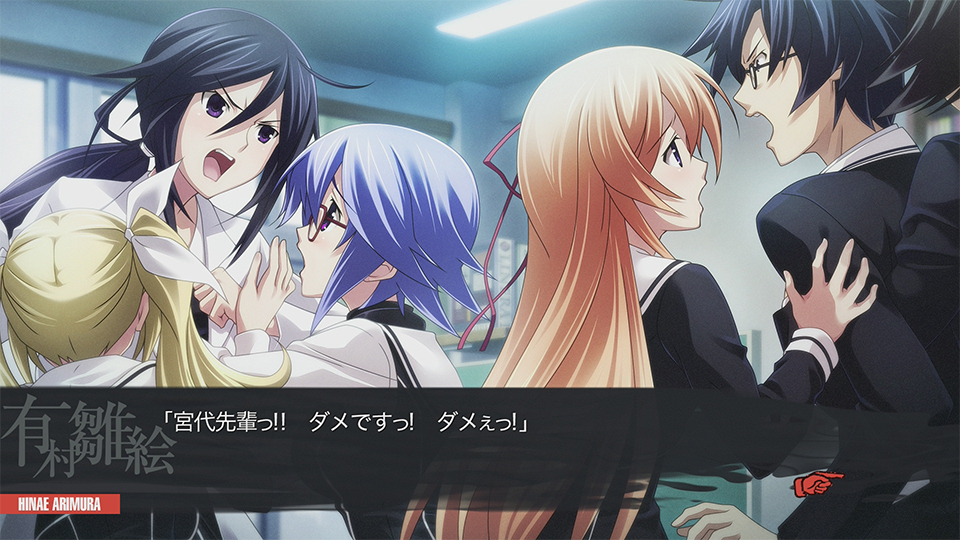
But is Chaos;Child any good?
Actually, it’s fantastic. It’s just below Steins;Gate in terms of story and characters and is way better than Chaos;Head. Some of the various routes through the story feel like either pure filler or are world-breakingly over-the-top, but the two or three core routes are just brilliant. It’s a great mystery with equally great pay off.
Anyway, that brings us to –
You promised me Gundams.
– Robotics;Notes.
GUNDAMS!
::Sighs:: Robotics;Notes is set in 2019 on the Japanese island of Tanegashima – which serves as one of JAXA’s (the Japanese NASA) launch sites. It follows a group of kids in their high school’s robotics club. The main character is Kaito, a hardcore fighting gamer who is hard pressed to do anything else. His best friend, Akiho, however, has a dream: to build a giant robot.
Gundam.
Well a “Gunvarrel”, but yeah, OK. A Gundam. Anyway, building it gets them involved in several mysterious occurrences: secret reports that hint of an impending apocalyptic conspiracy, monopoles literally falling from the skies, robotics malfunctioning with lethal results and an AI girl who likes to talk about the weather.
…You know, when you write it all out like this, Robotics;Notes is really weird.
I can see that.
Anyway, it plays similar to Steins;Gate, though Kaito uses an Android pad instead of a phone and can use its apps to affect the plot.
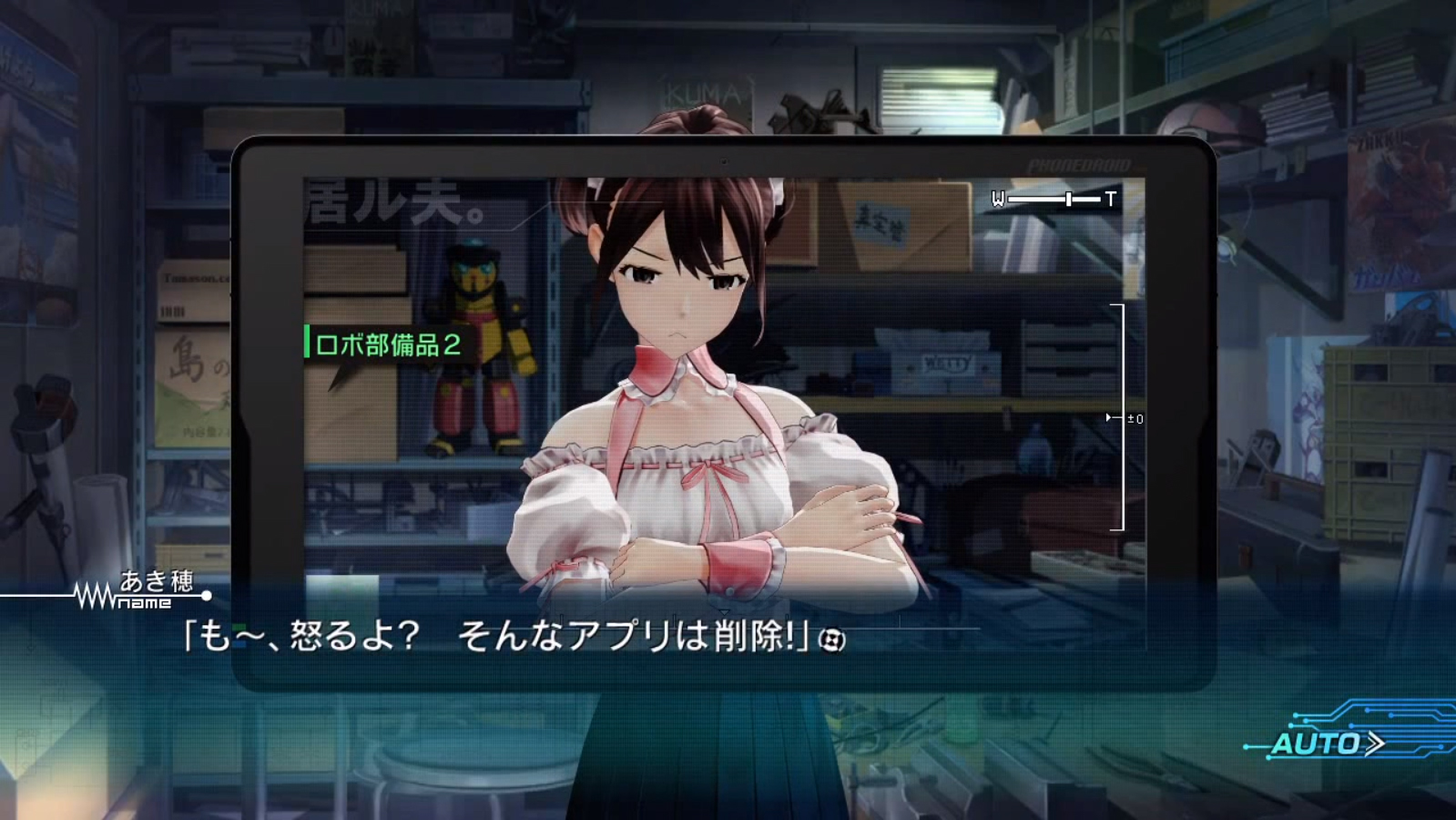
And the verdict?
Full confession, I have only seen the anime for this one (and rewatched it for this article) but have yet to play the game. So while I know the main story, I don’t know all the game-only routes.
That said, it’s… OK. It has some really great parts – especially the climax – and several of the characters are fantastic. But it kind of feels like it suffers from the shotgun approach to storytelling: do enough plotlines and some of them will hit home.
OK… So that‘s all the main games, right? Even after all that (beyond the obvious sequels), I don‘t see how these games with time travel, reality-altering powers and robotics are all related other than being in the same world.
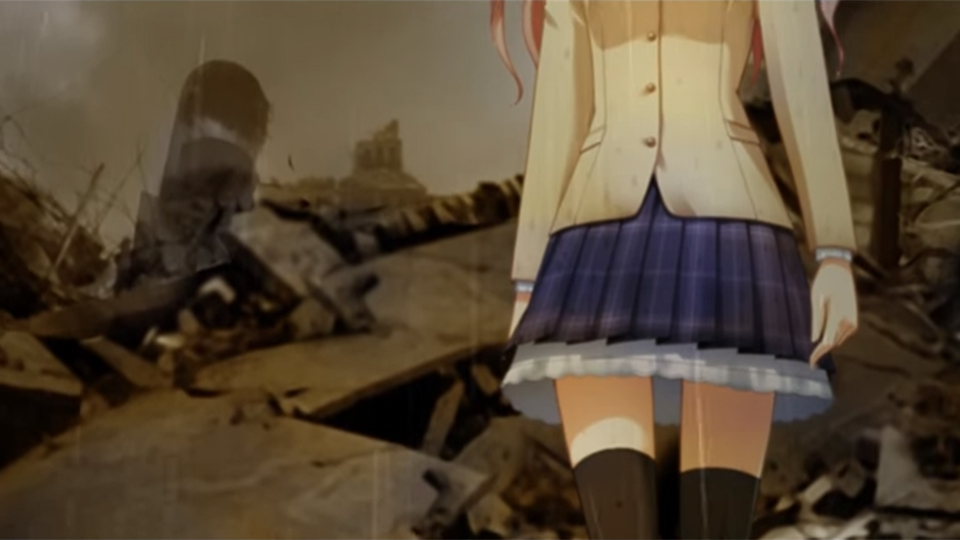
Basically, the thing that ties all the games together is their villain. Lurking in the background of each is the Committee of 300. Based on the real world conspiracy theory of the same name, the Committee of 300 seeks world domination – and while they already have enough money and power to get away with murder (literally), they want complete control.
I see. Like say, over time.
Or over reality itself.
Or… Gundams…?
The giant robots are more of a means to an end than the end itself.
I‘ll take your word for it.
Man, Robotics;Notes is so weird.
I‘m getting that vibe.
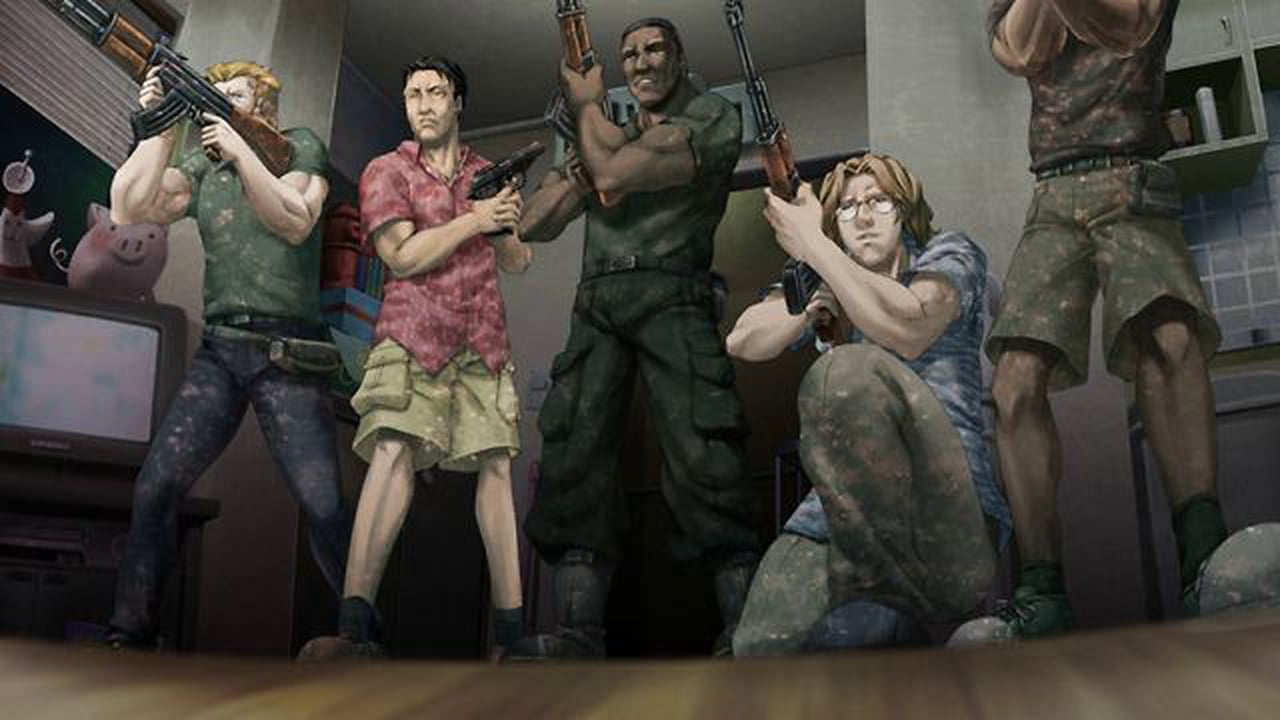
But anyway, Committee of 300 proves to be a great villain. They control corporations, political parties and religions – really, anyone you know could be an agent of theirs. They’re so massive that even when the heroes have a time machine or superpowers, the Committee still seems unbeatable. Moreover, most of the time, they don’t even seem to care that our heroes exist and let them run wild – until the moment they suddenly (and lethally) change their minds anyway.
Alright, so you‘ve sold me. Where can I play these?
Well, there’s the issue…
Break it down for me.
- Chaos;Head has never been officially released in English – though there is an anime adaptation of it.
- Steins;Gate has both an official English release and a fantastic anime.
- Steins;Gate 0 is new and has neither – though there is a special anime lead-in episode for it that aired along with the game’s Japanese release.
- Chaos;Child is in Japanese only, but it will be getting an anime in mid-2016.
- Robotics;Notes is also Japanese only; however, it has an anime adaptation.
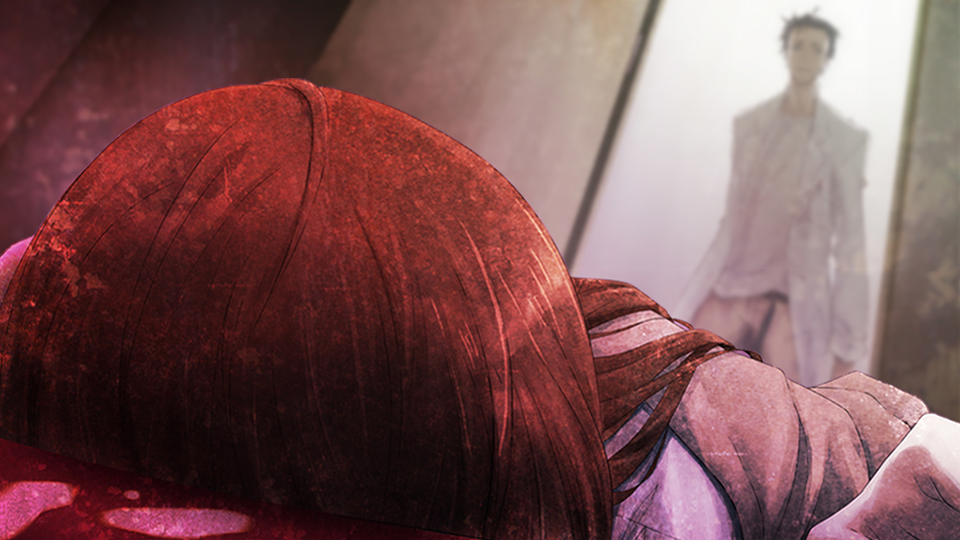

Comments
6 responses to “The Massive World Of Steins;Gate, Explained ”
Great article, I didn’t realize all of these were linked and shall proceed to watch some of the others. I adored Steins;Gate when I finally 100% finished it on Vita recently.
El Psy Congroo.
How faithful/complete are the anime versions of these games? Would you say that whatever was inevitably cut is worth going through the trouble of getting the games and the fan translations?
From what I’ve played of the VN, Steins;Gate is very close
How about Occultic;Nine?,.any new update on this (g)old articles?
If you like the style of the Science Adventure games/anime/manga/media, I highly recommend the manga Purple the Qualia.
I agree. Steins;Gate is #1.